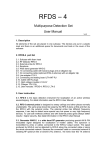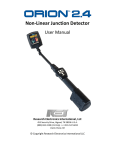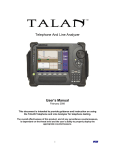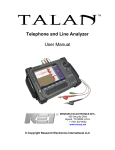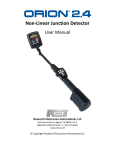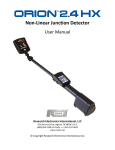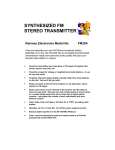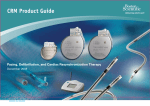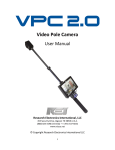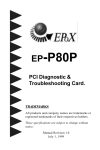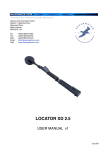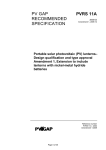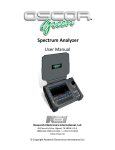Download the CPM-700 Manual
Transcript
C P M- 7 0 0 COUN TE R S U R VEIL LAN C E PR O B E/ * MON ITOR *CPM-700 is available with sev eral optional probes a nd accessories; some of which are pictured above. This manual addres ses availabl e probes and accessorie s with the CPM-7 00, however these probes and accessori es are not necessarily included with each CPM-700. PREC AUTIO N / WARNING ! The overall effectiveness of this product is directly dependent on your familiarization and level of threat. T his manual is marked * in areas where special a ttention is required. This manual c ontains proprietary information intended solely for use with the CPM-700 an d CPM-700 Probes and Accesso ries. All information contained within this manual is subject to change withoutnotice. O WNER’S REC O RD The Serial Number of your unit is located on the side panel. Please rec ord this number and refer to it whenever you contact your dealer or Research Electronics International concerning this product. Note: Removal or alteration of the serial number automatically voids all warranties of this product. MO DEL: CPM-700 SERIAL NUMBER: ___ _______________ TABLE OF CONTENTS TABLE OF CONTENTS INTRODUCTION............................................................. 1 CPM-700 PACK AGES . . . . . . . . . . . . . . . . . . . . . . . . . . . . . . . . . . . . . . . . . . . . . . 2 FEATURES OF THE CPM................................................... 5 POWER SUPP LIES, P ROBES, ACCE SSORIES . . . . . . . . . . . . . . . . . . 5 F RO N T P AN E L F EATUR ES . . . . . . . . . . . . . . . . . . . . . . . . . . . . . . . . . . . . . . . . . 9 AU DI O GROUP . . . . . . . . . . . . . . . . . . . . . . . . . . . . . . . . . . . . . . . . . . . . . . . . . . . . . . 9 MONITOR GROUP . . . . . . . . . . . . . . . . . . . . . . . . . . . . . . . . . . . . . . . . . . . . . . . . . . 9 DISPLAY GROUP . . . . . . . . . . . . . . . . . . . . . . . . . . . . . . . . . . . . . . . . . . . . . . . . . . 1 0 P RO BE GROUP . . . . . . . . . . . . . . . . . . . . . . . . . . . . . . . . . . . . . . . . . . . . . . . . . . . . 1 1 SIDE PANEL FEATURES . . . . . . . . . . . . . . . . . . . . . . . . . . . . . . . . . . . . . . . . . . . 1 1 POWER SOURCES......................................................... 13 A LKA LI NE BA TTE R Y OPE RA TIO N . . . . . . . . . . . . . . . . . . . . . . . . . . . . . . A C A DAPT ER OPE RAT IO N . . . . . . . . . . . . . . . . . . . . . . . . . . . . . . . . . . . . . . OP TI O NAL R E CHAR GEA BLE BA T TER Y OP ERA TIO N . . . . . . . CHARGI NG INSTRUCTIONS . . . . . . . . . . . . . . . . . . . . . . . . . . . . . . . . . . . 13 13 13 13 BASIC CPM-700 RF PROCEDURE.................................... 15 R F C O NSI DE RA TI O N S . . . . . . . . . . . . . . . . . . . . . . . . . . . . . . . . . . . . . . . . . . . 1 6 PE RFO RMING A “ WALK A ROU ND R OOM SWEEP” . . . . . . . 1 6 DETAILED CPM-700 PROCEDURE................................... 19 ME TE R CA LI BRATION . . . . . . . . . . . . . . . . . . . . . . . . . . . . . . . . . . . . . . . . . . . . K NOW N SOU ND S OU RC E . . . . . . . . . . . . . . . . . . . . . . . . . . . . . . . . . . . . . R F P R OBE A NA LY SI S . . . . . . . . . . . . . . . . . . . . . . . . . . . . . . . . . . . . . . . . . . . . . B R OA D BA ND RF A NA LY S IS ( 2 GHZ – 1 2 GHZ) . . . . . . . . . . . . . DETAILED INSPE CTI ON SWEEP . . . . . . . . . . . . . . . . . . . . . . . . . . . . . . . . P HONE / LI NE RF SWEEP . . . . . . . . . . . . . . . . . . . . . . . . . . . . . . . . . . . . . . . . . T RA CK I NG D E V I C E S . . . . . . . . . . . . . . . . . . . . . . . . . . . . . . . . . . . . . . . . . . . . . . V LF P R O BE . . . . . . . . . . . . . . . . . . . . . . . . . . . . . . . . . . . . . . . . . . . . . . . . . . . . . . . . . . AU DI O TE STI NG . . . . . . . . . . . . . . . . . . . . . . . . . . . . . . . . . . . . . . . . . . . . . . . . . . MI SC. WIRE / AU DI O EVALUA TI ON . . . . . . . . . . . . . . . . . . . . . . . . . . 19 19 20 22 24 25 26 27 29 30 PLANNING AND CONDUCTING A SWEEP...................... 31 SWEEP P REPA RA TION . . . . . . . . . . . . . . . . . . . . . . . . . . . . . . . . . . . . . . . . . . . . E ST AB LI S H A “ GAME P L A N” . . . . . . . . . . . . . . . . . . . . . . . . . . . . . . . . . . . . SWEEP TIPS . . . . . . . . . . . . . . . . . . . . . . . . . . . . . . . . . . . . . . . . . . . . . . . . . . . . . . . . . P HY SI CA L SEA R C H . . . . . . . . . . . . . . . . . . . . . . . . . . . . . . . . . . . . . . . . . . . . . . . . i 31 31 32 34 REI CPM-700 TABLE OF CONTENTS OTHER PROCEDURES AND EQUIPMENT ........................ 37 SPECIFICATIONS........................................................... 41 WARNINGS .................................................................. 45 TSCM TRAINING REI Center for Technical Security: REI offers the World’s largest unclassified commercially available Technical Surveillance Countermeasure (TSCM) training facility. Training courses include classroom instruction and handson exercises where students perform sweep exercises in “live” environments utilizing “target rich” project rooms. The progressive course curriculum is designed for the beginner or the seasoned TSCM Technician. Regularly scheduled courses are taught monthly; visit REI’s website (www.reiusa.net) or contact REI ([email protected]) for training dates. Contact REI for more information TSCM training and/or other TSCM equipment visit www.reiusa.net. REI CPM-700 ii INTRODUCTION INTRODUCTION The CPM-700 Countersurveillance Probe/Monitor is a universal sweep tool that can be used to detect and locate a wide variety of surveillance devices. A broad range of probes and accessories are available for the CPM-700 to expand the CPM’s countersurveillance capabilities. NOTE: Depending on the CPM-700 package purchased, and/or additional probes purchased, you may or may not have all the probes and accessories discussed in this manual. The CPM-700 detects and locates transmitting devices, quickly and silently, including: • AF (Audio Frequency)……...100 Hz to 15 kHz. • VLF (Very Low Frequency)….15 kHz to 1 MHz and carrier current • RF (Radio Frequency...……..50 kHz to 3 GHz With the additional probes and accessories, the CPM can detect and locate: • High Frequency transmitters (3 - 12 GHz, such as 802.11 wireless networks and 5.8 GHz cordless telephones, with BMP-1200) • Infrared transmitters (with IRP-700) • Magnetic Leakage (with MLP-700) • Acoustic Leakage vulnerability (with ALP-700) Special Note The overall effectiveness of any technical surveillance countermeasure is directly dependent on the level of threat and the users ability to properly deploy the appropriate countermeasure. Familiarization with the level of threat, the physical and technical environment, and most importantly the capabilities of the CPM700 is critical to using the CPM-700 successfully. The manufacturer makes no guarantee about the performance of the unit when attempting to detect hidden electronic devices. It may be necessary to employ other supplementary equipment and/or procedures. REI’s Center for Technical Security offers training on technical surveillance countermeasure equipment. The section “Planning and Conducting a Sweep” contains many practical tips for getting the most out of your CPM and other countersurveillance equipment. 1 REI CPM-700 INTRODUCTION CPM-700 PACKAGES Several probes and accessories (some of which are optional) are available for the CPM-700. Many of these probes and accessories are available separately, but also in the packages listed below: CPM-700 STANDARD The CPM-700 STANDARD package provides the basic tools for users who are only concerned with minimal RF testing; the CPM700 STANDARD package includes the following: • • • • • • • CPM-700 Countersurveillance Probe/Monitor Standard RF Probe (50kHz-3GHz) VLF Carrier Current Probe TVLF Patch Cable Auxiliary Patch Cable Headphones Soft carrying case This is the most basic package providing for TSCM RF testing up to 3GHz. CPM-700 ADVANCED PACKAGE The CPM-700 ADVANCED package is designed for users who have a need for additional TSCM testing (IR, Acoustic Leakage, Network and Telephone wiring testing, etc.). This package also provides several convenience accessories and includes the following: • • • • • • • • • • CPM-700 Countersurveillance Probe/Monitor Standard RF Probe (50kHz-3GHz) Acoustic Leakage Probe Infrared Probe VLF Carrier Current Probe TVLF Patch Cable Magnetic Leakage Probe Auxiliary Patch Cable Modular Phone Adapter for network and phone line testing Tape Recorder Patch Cords REI CPM-700 2 INTRODUCTION • • • • Cigarette Lighter Adapter for powering the CPM from a 12VDC automobile socket Rechargeable Batteries Headphones Soft carrying case This package includes several accessories for RF analysis up to 3GHz, Infrared analysis, acoustic leakage testing, network and telephone testing adaptors, and other accessories. (12GHz) The CPM-700 DELUXE package is designed for the serious TSCM user who wants to get the most out of the CPM-700. This package includes all currently available probes and accessories, including the directional Broadband Microwave Probe, which extends the range of the CPM-700 to 12GHz and adds additional sensitivity in the common 2.4 GHz range over the Standard RF Probe. The CPM700 DELUXE package includes the following: CPM-700 DELUXE PACKAGE • • • • • • • • • • • • • • CPM-700 Countersurveillance Probe/Monitor Standard RF Probe, frequency range of 50kHz-3GHz Broadband Microwave Probe (BMP-1200), frequency range of 2GHz-12GHz (This probe is directional and much more sensitive than the standard RF probe in the common 2.4GHz range.) Acoustic Leakage Probe for evaluating structural bound audio leakage RF Sniffer Probe (10MHz-3GHz) for pinpointing surveillance devices where the Standard RF Probe may become saturated with RF energy Infrared Probe VLF Carrier Current Probe TVLF Patch Cable Magnetic Leakage Probe Auxiliary Patch Cord Modular Phone Adapter for network and phone line testing Tape Recorder Patch Cords Cigarette Lighter Adapter for powering the CPM from a 12VDC automobile socket Rechargeable Batteries 3 REI CPM-700 INTRODUCTION • • Headphones Deluxe Hard-shell Case to carry the CPM and all probes and accessories The CPM-700 Deluxe package includes all current available probes (including RF up to 12GHz, Infrared, Carrier Current, Acoustic Leakage, etc.), and all available accessories and provides the widest range of test capabilities with the CPM. Most of the probes and accessories are available separately for replacement; contact REI for replacement probes. Broadband Microwave Probe Upgrade For CPM owners who would like to add the Broadband Microwave Probe (BMP-1200) to their existing CPM (extending the frequency range to 12GHz), REI offers the BMP-1200 Upgrade package, which is backwards compatible with all existing CPMs. The BMP-1200 Upgrade includes the following: BMP-1200 • • • • BMP-1200 Probe (2GHz-12GHz) RF Sniffer Probe (10MHz-3GHz) Acoustic Leakage Probe Deluxe Hard-shell Case The CPM-700 provides a wide range of tools in a single easy-to-use portable kit. Whatever your needs, there is a CPM package that will accommodate you. REI CPM-700 4 FEATURES OF THE CPM FEATURES OF THE CPM POWER SUPPLIES, PROBES, ACCESSORIES 1. Power Sources / Selector Switch: a. Alkaline Batteries (8 AA cells) - Remove back cover of CPM by turning two fasteners one-quarter turn counterclockwise. Set the switch to “ALKALINE.” Selector switch in back of CPM is factory set to “ALKALINE” Do not charge Alkaline batteries. Damage to the unit will occur. b. Using Rechargeable Ni-MH or Ni-Cad Batteries (8 AA cells) – Set the switch to “RECHARGEABLE.” Charge at least eight hours or overnight. Connect the AC adapter to the side of the CPM and plug in to a wall outlet. All rechargeable batteries must be charged before use. c. AC Adaptor – Connect the adapter supplied by REI to an AC outlet and to the Adapter input of the CPM-700. If rechargeable batteries are installed, the AC adapter will charge them. The CPM-700 will automatically operate on the battery pack if the AC power fails. NOTE: Do not use any adapter other than the one supplied by REI. 5 REI CPM-700 FEATURES OF THE CPM 2. Standard RF Probe: Checks your environment for hidden phone or room-audio bugs; video transmitters; pulsed tracking transmitters; remote control, frequency-hopping, spreadspectrum, and burst devices up to 3GHz. 3. VLF Probe: Tests for carriercurrent bugs that use AC wiring (or other misc. wiring like telephone, burglar alarm, thermostat wiring, etc.) as a transmission path (max input 300VAC). With TVLF adapter attached to the VLF probe, test for carrier current devices on any pair of conductors (max input 300VAC). 4. Auxiliary Input Amplifier: Allows you to listen to suspicious telephone or room wiring for the presence of buried microphones or modifications to equipment. REI CPM-700 6 FEATURES OF THE CPM 5. BMP-1200 Broadband Microwave Probe: Receives RF energy between 2GHz and 12GHz, including frequencies used for wireless networks and many cordless telephones. 6. RF “Sniffer” Probe: Helps to isolate ‘threat’ transmissions from legitimate broadcast transmissions in RF-rich environments up to 3GHz. Must check within 18” of every object in the target area. 7. IRP-700 Infrared Probe: Locates infrared transmissions. 8. MLP-700 Magnetic Leakage Probe: Locates carrier current devices, tape recorders and video cameras. 7 REI CPM-700 FEATURES OF THE CPM 9. MPA Modular Phone Adaptor: Rapidly tests each pair of conductors in telephone and network cables or carrier current or audio transmissions Testing for carrier current devices Testing for line audio Modular Phone Adapter (MPA) Cable from telephone TVLF Adaptor Auxiliary Patch Cable VLF Probe To CPM To CPM 10. TVLF Adaptor: Adapts VLF Probe to check any kind of wiring (not just wall outlets) for carrier current devices (see above). 11. ALP-700 Acoustic Leakage Probe: Detects and evaluates areas vulnerable to acoustic leakage. (Also used with testing of REI’s ANG 2200 – Acoustic Noise Masking System.) 12. NCB: Rechargeable battery pack, 8 Ni-MH cells, size AA 13. CLA: 12 VDC automotive cigarette lighter adapter REI CPM-700 8 FEATURES OF THE CPM FRONT PANEL FEATURES 1 2 6 3 7 4 8 5 9 10 11 12 AUDIO GROUP PHONES (1): Allows the use of silent headphone detection, disconnects the internal speaker. GAIN (2): Controls the Audio Gain (volume) to the speaker or Headphone Output. Does not affect Record Out level. FILTER (3): The audio Filter will “band-pass” the audio response for voice levels by enhancing the 500 Hz to 2.5 kHz frequencies. The Filter also removes much of the AC hum on the Auxiliary Input, or video hum when using the RF Probe Input. The Filter processes the audio for both the headphones and the record-out jack. Display shows whether filter is IN or OUT. MONITOR GROUP MODE (4): Sets the unit to its Search or Monitor function. The SEARCH mode is used for performing a sweep. The MONITOR mode is used after a sweep to check continually for new devices. Display shows whether Mode is SEARCH or MONITOR With the CPM in MONITOR mode, a new signal stronger than the THRESHOLD level (see below) will cause the ALERT LED to flash, and the CPM will make an audible TONE. 9 REI CPM-700 FEATURES OF THE CPM The remaining functions in this group are active only while in the MONITOR mode: SILENT/TONE (5): Silences the audible beeper during an ALERT. The LED will continue to flash. Display shows whether CPM is in TONE or SILENT mode. THRESHOLD (6): Moves a pulsing segment to any position on the LCD Bar graph. When the input level exceeds the pulsing segment, the CPM-700 enters an Alert Mode and activates the Remote Output. The THRESHOLD control is active only in the MONITOR mode. ALERT (7): LED flashes red while in ALERT mode. DISPLAY GROUP INPUT LEVEL (8): Bar graph indicates signal strength of Probe or Auxiliary Inputs; compressed semi-logarithmic with two sensitivity scales. PULSING SEGMENT (9): In MONITOR mode only, displays the Threshold Point that will activate the Alert mode and Remote Output. LOW BATT (not shown): Battery voltage indicator; indicates approximately 10% remaining power. STATUS DISPLAY (10): Shows unit operating conditions made by switch selections and input used. NOTE: This status display figure is used in this manual to help you verify the current setup. Only one label per block appears at any one time on the actual display, depending on the switch settings. REI CPM-700 10 FEATURES OF THE CPM PROBE GROUP PROBE (11): Input jack for CPM probes. This jack also provides power to “active” CPM probes. The CPM-700 will automatically select this input when a CPM Probe is connected. Connect only CPM probes to this jack. Display shows whether PROBE or AUX jack is in use. GAIN (12): Selects the internal sensitivity of the Bar graph and audio systems. The HIGH position provides additional Gain to boost low-level input signals. Display shows whether HIGH Gain or LOW gain is selected. SIDE PANEL FEATURES A B C D E F A. AUXILIARY INPUT: Audio input for internal amplifier. Use to test wires for the presence of audio or control signals. B. METER: Calibrates the LCD Bar graph to the HIGH GAIN setting. C. REMOTE: Connects to “remote” compatible input of audio recorder. Use to start/stop the recording function. D. RECORD: Provides low level audio output of received sounds, connects to “microphone” input of recorder. E. CHARGE: LED indicates charging of nickel-metal-hydride battery. F. ADAPTER: Accepts power from AC Adapter, and charges nickelmetal-hydride battery pack (make sure switch is set to “RECHARGEABLE”). 11 REI CPM-700 POWER SOURCES POWER SOURCES The CPM-700 can be operated by Alkaline batteries, the AC Adapter, or an optional rechargeable nickel-metal-hydride battery pack. ALKALINE BATTERY OPERATION Remove the rear cover panel on the CPM-700 by turning the two fasteners one-quarter turn counterclockwise. Install eight AA (MN 1500) alkaline cells in the pack as shown in the holder. Typical operating time on Alkaline batteries is from 10-15 hours. Set the Battery Selector Switch to the ALKALINE (MN 1500) position. Do not attempt to charge Alkaline batteries. Damage to the unit may occur. Replace the battery pack and rear cover. AC ADAPTER OPERATION Connect the AC adapter supplied by REI to an AC outlet and to the Adapter input of the CPM-700. If rechargeable batteries are installed, the AC adapter will charge them (see below). OPTIONAL RECHARGEABLE BATTERY OPERATION A rechargeable battery pack is available from REI. Or, you may purchase eight AA cells locally. CHARGING INSTRUCTIONS REI recommends that you use only high quality rechargeable cells. All NiMH or Ni-Cad batteries must be charged before use. Charge at least eight hours or overnight. Be sure to set the internal Battery Selector Switch to the RECHARGEABLE position, so the batteries will recharge while it is operating from the AC Adapter. NOTE: The CPM-700 will automatically operate on the battery pack if the AC power fails. This is to provide continued monitoring even in the event of a power interruption. To avoid accidentally running down the batteries, be sure to verify that the AC supply is good. NOTE: Do not use any adapter other than the one supplied by REI. Typical operating time is 12-15 hours on high quality nickel-metal-hydride batteries. If you choose to use rechargeable battery power “in the field” with no AC power outlets available, a spare “back-up” Alkaline pack is a good idea. 13 REI CPM-700 POWER SOURCES The Charge LED light indicates the status of the power/battery circuits. a. If batteries are installed and the AC Adapter is connected, the LED should be on. If not, check the Battery Selector Switch position inside the battery compartment, the AC outlet for power, proper polarity of each cell, and cell-to-cell contact in the battery holder. If these are correct, then there may be a bad cell in the pack or a defective AC Adapter. b. The charge LED should not be lit when either Alkaline or no batteries are installed. NOTE: Rechargeable cells will sometimes develop an internal short when left discharged for long periods or when run flat (fully discharged). It is recommended the battery pack be charged overnight after being run flat and once every three months when not in use. If your battery pack develops a shorted cell the “Low Batt” message will be displayed after a brief period (up to 15 min. with RF Probe). If this happens try an overnight charge to correct; otherwise, replace the defective cell. REI CPM-700 14 BASIC CPM-700 RF PROCEDURE BASIC CPM-700 RF PROCEDURE Surveillance devices use several means to capture information and deliver it to a “listening post.” A ‘bug’ may transmit information using RF energy to a listening post. Or it may send information out along ordinary power lines or phone lines. Information may be analog (modulated onto the signal) or digital (encoded into a series of 1’s and 0’s that will be de-coded at the listening post). Some of the transmission paths that may be used to steal information: Acoustic leakage through walls, onto windows, and above ceilings ‘Bugs’ using RF transmissions Room or telephone wiring Everywhere in the world, we are surrounded by transmitted signals: Radio and TV stations, cellular phones, and wireless networks are just a few of the many electronic devices that use RF energy to transmit information. The CPM-700 works by helping you to identify which signals are legitimate signals, and which are threats to your security. To do this, you must first establish a ‘base-line’ of signals in the ambient environment, and then use the CPM to find signals that are threats. 15 REI CPM-700 BASIC CPM-700 RF PROCEDURE RF CONSIDERATIONS The CPM-700, with the Standard RF Probe, detects and locates audio or video surveillance transmitters (bugs) broadcasting from 50 kHz to 3 GHz. The BMP-1200, included in the CPM-Deluxe, extends the CPM’s frequency range to 12 GHz. The CPM’s bar graph shows the effects of RF field intensity as you approach a transmitting device, and the received audio can help you to discern between a friendly local source of RF and an actual bug. The CPM700 will display an increasing level on the bar graph as you approach a stronger RF level. The detection range depends on two major factors: 1) The bug’s output power, antenna efficiency, and pattern; and 2) The surrounding RF environment such as commercial radio/TV and two-way radio transmission. Other, minor factors are the frequency of the transmission and probe antenna’s length in the case of the Standard RF Probe. To find the location of a hidden surveillance transmitter, find the area of the room that produces the highest level on the bar graph. A “walk around sweep” will locate the area of a room that is “HOT” with RF energy. PERFORMING A “WALK AROUND ROOM SWEEP” 1. With the headphones on, holding the RF Probe by the foam grip, position the probe vertically while holding it out in front of your body. (See page 22 for information on using the Broadband Microwave Probe (BMP-1200)). 2. Enter the target area while noting the average bar graph Level. If the bar graph displays “MAX”, use Low Gain. If the bar graph still displays “MAX” on Low Gain, shorten the probe antenna. (See page 22 for information on using the Broadband Microwave Probe (BMP-1200)). REI CPM-700 16 BASIC CPM-700 RF PROCEDURE 3. Make a 360-degree walk around the target area while watching the bar graph display. It will move up and down the scale as the unit senses various RF levels. 4. Locate the highest RF level in the room by moving the Probe in all directions and watching the bar graph display. 5. Probe all objects that could contain a hidden surveillance device. You will see as you get close to the source of RF energy that the bar graph will continue to rise. (Use Low Gain if “MAX” is displayed.) 6. Turn off, and back on again, the lights and other equipment in the target area. Watch for noticeable changes in the bar graph display. Sometimes a faulty fluorescent lamp will produce strong RF interference. The lamp can be removed or replaced. If the rise in the bar graph cannot be attributed to such legitimate interference, then suspect a bug in the area. 7. Verify any detected RF signals to determine if the signal is an actual surveillance device or a local “friendly” signal. Listening with the headphones, determine if the energy is a local TV video, FM radio or two-way transmission. Hearing your Known Sound Source (see page 19) is positive identification of an analog surveillance device. The compact disc provided with the CPM-700 contains examples of various transmissions. Be aware that if there is a strong RF signal, but no audible audio, there is still a potential that the signal is a digital surveillance device. There are many other ways to use the CPM-700 than this basic description. Please see additional details in the “DETAILED CPM-700 PROCEDURE” section and the “PLANNING AND CONDUCTING A SWEEP” section. REI offers regularly scheduled (monthly) Technical Security CounterMeasures (TSCM) training courses. Contact REI or visit our web site www.reiusa.net for more info. 17 REI CPM-700 DETAILED CPM-700 PROCEDURE DETAILED CPM-700 PROCEDURE METER CALIBRATION The CPM-700 utilizes high performance components and temperature compensation to provide stable, accurate operation. Due to the high system gain, changes in temperature, humidity or component aging may require the CPM to be adjusted periodically. Meter Calibration is performed by plugging the VLF Probe into the CPM Probe Input (this selects the Probe Input). NOTE: Do not plug the VLF into any outlets during this adjustment. Adjust the Meter Calibration Control on the side panel, using a small flatblade screwdriver, until the display reads two to three segments on the High Gain setting. KNOWN SOUND SOURCE A “Known Sound Source” provides two very important functions. 1. It “masks” most of the inspection noises made during a physical search. 2. It gives a recognizable sound within the sweep area, which, when received through the CPM-700, will identify the existence of a surveillance device (Caution: If a digital transmitter is present, you will hear audio variation based on the type of digital modulation, but you will NOT hear the known sound source through the CPM.) Any CD or MP3 player will provide a Known Sound Source within the sweep area, but usually a unit with medium size speakers will give the best results. Choose a sound source that is normal or appropriate for the environment being inspected (i.e. music may not be normal to a business setting, etc). Bring a sufficient quantity, since a quality sweep includes a physical search, which may take many hours. Note: Do not use a radio as a Known Sound Source since it is possible to receive the same station through the CPM-700. This would falsely indicate the radio station’s signal is a surveillance device. 19 REI CPM-700 DETAILED CPM-700 PROCEDURE RF PROBE ANALYSIS The Standard RF Probe contains a low noise, broadband amplifier (50 kHz to 3 GHz) which boosts the weak “near field” signals emitted from RF transmitters. Signal strength is displayed by the CPM-700 bar graph in either high or low sensitivity ranges and is used to indicate the location of an RF device by “homing in” on the highest level. CAUTION: The RF Probe can be damaged by a highlevel electrostatic discharge to the antenna. In an area where static discharges are likely, such as in dry conditions, or on carpeting, touch each object to be tested with your hand, if possible, before making antenna contact. *WARNING: Do not contact live power circuits! A note concerning modulation: The CPM-700 is primarily sensitive to amplitude information. Some transmitters may employ an unusual type of modulation, hop frequencies, store information and output it in a burst or have a very narrow bandwidth. These devices may not provide a strong audio signal and therefore the CPM-700 may not give a clear audible output of the Known Sound Source, but may only show a reading on the LCD bar graph. Be sure to investigate all suspicious RF levels. A note concerning frequency: The CPM-700 and the Standard RF Probe comprise a broadband RF receiver covering frequencies from 50kHz to 3GHz. Generally, the RF Probe is used extended to its full length. You can, however, shorten the antenna to make a more focused search for higherfrequency (i.e., shorter-wavelength) signals. The Broadband Microwave Probe covers frequencies from 2GHZ – 12GHz, and is directional. A note concerning power: Surveillance RF transmitters can be divided into four power groups: micro power, low power, medium power, and high power. Transmitting distance is dependant not solely on power but also antenna placement and design, structural environment, ambient noise, and the receiver and its antenna. High power bugs generally, though, can broadcast a quarter mile or more with 100 milliwatts. Medium power devices use 1 to 100 milliwatts for a distance of 300 feet to a quarter mile. REI CPM-700 20 DETAILED CPM-700 PROCEDURE Low power bugs transmit less than 300 feet, using less than 1 milliwatt. A separate breed of transmitters, called “micro power bugs” is designed to be undetectable with a power of one microwatt or less. These specialized bugs are very small, with short antennas. The monitor must be very close and very sophisticated. Because of unknowns when planting an RF device, the eavesdropper will use more than minimum power for reliability. RF PROBE Set-up These procedures apply for each use of the Standard RF Probe (50kHz to 3GHz). 1. Install the Headphones, turn the Audio Gain Control to low position (counter-clockwise). 2. Press the Mode Switch to the Search position (in). 3. Connect the RF Probe to the Probe Input and extend the antenna to its full length. 4. Press the Power Switch to activate the unit, and observe the status display: 5. Select High Gain level. If a strong ambient noise level is displayed on the bar graph (more than ten segments), you will need to select Low Gain and then, if necessary, shorten the antenna. 6. Adjust the Audio Gain Control to a comfortable monitoring level. 7. Use the probe near all surfaces to be “swept” for potential transmitters. Changes in the bar graph on the CPM-700 and significant audible noise changes may be indicators of transmitters. Investigate all suspicious indicators. 21 REI CPM-700 DETAILED CPM-700 PROCEDURE BROADBAND RF ANALYSIS (2GHZ – 12GHZ) The Broadband Microwave Probe (BMP-1200), optional with some CPM700 packages, has a frequency range of 2 GHz to 12 GHz) and is sensitive to horizontal and vertical orientation as well as being directional. Signal strength is displayed by the CPM-700 bar graph in high gain sensitivity range and is used to indicate the location of an RF device by “homing in” on the highest level. Be sure to investigate all suspicious RF levels. BROADBAND MICROWAVE PROBE (BMP-1200) Set-up These procedures apply for each use of the Broadband Microwave Probe (BMP-1200). 1. Install the Headphones, turn the Audio Gain Control to low position (counter-clockwise). 2. Press the Mode Switch to the Search position (in). 3. Connect the Broadband Microwave Probe (BMP-1200) to the Probe Input. 4. Press the Power Switch to activate the unit, and observe the status display: 5. Select High Gain level on the CPM-700. If a strong ambient noise level is displayed on the bar graph (more than ten segments), you may want to use the attenuator built into the BMP by squeezing the Attenuator button on the BMP (identified by a green or orange light). An orange light on the BMP indicates that the attenuator is active (20dB); squeeze the attenuator button again to de-activate the attenuator (0dB) indicated by a green light. 6. Adjust the Audio Gain Control to a comfortable monitoring level. REI CPM-700 22 DETAILED CPM-700 PROCEDURE 7. Hold the Broad Band Microwave Probe in your hand at the base of the probe (as shown in the picture). 8. Use the probe directionally, oriented both horizontally and vertically, as well as near all surfaces and objects that could contain a hidden surveillance device while watching the bar graph display. The bar graph display will move up and down the scale as the unit senses various RF levels. 9. As described earlier in the PERFORMING A “WALK AROUND ROOM SWEEP” section on page 16, locate the highest RF level in the room. You will notice as you get close to a source of RF energy that the bar graph will continue to rise. Turn off, and back on again, the lights and other equipment in the target area and watch for noticeable changes in the bar graph display (fluorescent lights and other devices may produce strong RF interference and create “false positive” indications). 23 REI CPM-700 DETAILED CPM-700 PROCEDURE DETAILED INSPECTION SWEEP Please note that in some areas which are close to high power commercial transmitters such TV, AM or FM radio you will be using the Low Gain setting (areas with more than ten segments displayed in Low Gain). It is normal to see large signal level variations located throughout your sweep area. Often, when the Probe is held near wires or a metal object, the bar graph level will increase, as well as the activity heard through the headphones. This may not be a “bug,” but rather the metal acting as an antenna extension. Verify by listening for your Known Sound Source. There are available in the consumer market small FM wireless microphones. These broadcast on the commercial FM broadcast band. In order to meet FCC (USA) regulations, they must be very low power, about two microwatts. This extremely low power makes them difficult to resolve using the CPM-700. Fortunately, it also makes them quite useless as bugs due to their short range – less than fifty feet under most circumstances. Again, a close physical search, using the CPM-700 as an inspection tool, is necessary. NOTE: For best results in an RF-rich environment, test each object in the room by placing the RF Probe against it, and noting if the level is higher than the normal surrounding levels. The “Sniffer” Probe, included in the CPM-Deluxe kit, is also very effective at isolating undesirable transmissions in RF-rich environments. Video Transmitters Surveillance video transmitters sound the same through the headphones as a “friendly” local TV signal. In many cases you can compare the RF and audio signal levels by moving to another room. If you notice that a change in light level in the room also changes the tone of the video buzz, then localize the area that gives the strongest reading on the bar graph and search for a transmitter and/or camera. REI CPM-700 24 DETAILED CPM-700 PROCEDURE PHONE/LINE RF SWEEP To test a telephone for RF transmitters, measure the signal strength of the instrument and line when in an “off hook” (in-use) condition. Listen for a dial tone through the headphones to verify a phone bug. You may turn off or lower your Known Sound Source for this sweep since the telephone provides a dial tone and/or messages. If a long recorded message service is available, such as a business report or farm market report, use one of them as a Known Sound Source to disguise your actions. 1. With the CPM-700 next to the phone and the phone on hook, shorten the Probe’s antenna to approximately four inches (10 cm) to reduce ambient RF reception. Wrap the curly cord from the handset around the antenna at least four turns. 2. Compare the previous room levels to the measured (on hook) phone levels. If there is a substantial increase on this test an audio verification is necessary to determine if it is a “friendly” signal (possibly short-wave signals) or a phone powered room transmitter. 3. While noting the nominal RF level on the bar graph, lift the handset off the hook and look for an RF level increase (normally more than two segments). Listen for a dial tone through the Headphones. If the bar graph level increases or if a dial tone is heard in the headphones, this indicates a possible bug. A normal phone will cause only a small pop sound and a momentary jump in the bar graph. 4. Check the telephone instrument by repeating the above tests with the probe by the side of the telephone. Measure the difference between on-hook and off-hook. Listen for a dial tone. 25 REI CPM-700 DETAILED CPM-700 PROCEDURE 5. Check the line where it enters the wall by repeating the on-hook/offhook procedure. 6. Go to the patch panel or the telephone switching system and repeat the above; have someone go “on-hook” and “off-hook” while you are testing (if you have a long offhook message or alert tone, listen for it while testing). 7. Repeat the above tests at the meter (utility) room or outside at the drop point where the phone line enters the building. NOTE: A normal non-bugged phone or phone-line will present a momentary click and a small change in RF levels when the phone is taken off-hook, with no dial tone heard through the headphones. NOTE: With older type multi-line phones, which use 25- pair connectors, it is necessary to perform all the above tests and inspections on each instrument in the building. The older type phones can be used as a “remote location” to connect a surveillance device since all phone lines are available along the cable and within each telephone instrument. TRACKING DEVICES Using the Standard RF Probe, the CPM-700 can detect and locate certain types of RF tracking transmitters that are used to track vehicles. The typical “Bumper Beeper” uses an output of 100 milliwatts to more than 5 watts and usually has a pulsed output. Newer GPS (Global Positioning System) tracking devices are of two types: 1. Non-transmitting – these devices only log where a vehicle has been. They must be removed to be read or downloaded, and are not detectable with the CPM. 2. Transmitting – Usually on cellular phone frequencies, these devices transmit either: a) at regular intervals, or b) only when the GPS detects movement during a certain interval. REI CPM-700 26 DETAILED CPM-700 PROCEDURE VLF PROBE The VLF Probe detects and locates very low frequency devices, also known as carrier current transmitters. These transmitters use the AC power lines as a transmission path by placing a carrier signal on the line (FM wireless intercoms sold through electronics dealers are an example of a carrier current transmitter). Carrier current devices can also use other miscellaneous wires, cables, or phone lines. Some equipment with switching power supplies, such as computers, copiers, fax machines, etc. may produce VLF signals on the power lines. Selectively turn off these products one at a time to isolate which one may be causing the interference. Unless you are sure the interference is from a switching power supply, you must inspect the suspect equipment. 1. Install the Headphones and turn the Audio GAIN Control to a low (counter-clockwise) position. The status display reads: 2. Check the Meter Calibration. The bar graph should read two or three segments on HIGH GAIN. 3. First, plug the VLF Probe into an AC outlet in a low security setup area. Select HIGH or LOW GAIN as necessary. It is normal to have three to seven segments of AC hum. (Note the level on the bar graph for comparison.) It isolates the AC voltage while band passing the 15 kHz to 1 MHz frequencies to the CPM-700. 4. Plug the VLF Probe into an outlet in the “target area” and compare the level displayed on the bar graph to the level obtained from the “setup area.” 5. Adjust the Audio GAIN Control to a comfortable monitoring level and listen for the known sound source. 27 REI CPM-700 DETAILED CPM-700 PROCEDURE 6. Test other outlets by plugging in and comparing the bar graph level and audio sound. As you approach a VLF device the signal level on the bar graph will increase. Listen for your known sound source. 7. To test other wires, cables, or phone lines for the presence of VLF signals, including video: Connect the TVLF Adaptor to the probe and clip onto the suspect pair of wires. NOTE: Dimmer controls and defective fluorescent lamps may cause background hum and buzz due to AC power line harmonics. These can be reduced by removing or replacing the defective fluorescent lamp or by turning dimmer controls on full. Usage of the audio FILTER will also help reduce low frequency audio hum and buzz. Simply turning off the noisy circuit may also turn off the bug. NOTE: VLF frequencies normally will not pass through a separate power transformer; therefore be sure to check all outlets since they may be on different circuits (power phases). REI CPM-700 28 DETAILED CPM-700 PROCEDURE AUDIO TESTING The CPM’s Auxiliary Input amplifier is used with the supplied Auxiliary Patch Cable to “listen” to suspicious wiring for the presence of voices or other signals. The balanced input allows testing of phones and phone lines for modifications, and after-hour evidence monitoring. NOTE: Monitoring of phone lines is for temporary testing purposes only and is not to be used for surreptitious interception. *WARNING: The Aux Input is not to be connected to power lines or circuits with voltages over 52 volts. Unit damage or shock hazard may result! NOTE: The CPM audio amplifier is sufficient for lowlevel threats. For more sophisticated audio testing, the CMA-100 from REI provides additional amplification, voltmeter, voice band filters, and the ability to bias the line with voltage for additional testing. Unit Set-up for Audio Testing Remove any probe connected to the front panel Probe Input and plug the Auxiliary input Patch Cord into the side Aux Input. NOTE: The Auxiliary Input will not function if a probe is connected to the Probe input. NOTE: The CPM-700 utilizes an AGC (Automatic Gain Control) in the audio circuitry to control the volume and prevent overloads. The bar graph display will not be active beyond two or three segments when using the Audio Patch Cord. Phone Line Audio Test Test telephones and lines for devices such as infinity or harmonic bugs that listen to the room while on-hook. 1. Identify the ring and tip conductors of the phone line (usually red & green) and connect the Auxiliary Input Patch Cord to these points. 2. Listen through the Headphones for the Known Sound Source (a normal unmodified telephone will not pass audio when “on hook”.) If an “electronic trigger” is in use or a hook-switch bypass 29 REI CPM-700 DETAILED CPM-700 PROCEDURE has been made, you will hear the room’s audio. Check the phone and the line to locate the microphone. 3. You may wish to utilize the CPM-700 Monitor Mode since these remotely controlled devices may not be operational during the initial test. MISC. WIRE / AUDIO EVALUATION Listen to any ‘unknown’ wires and cables you discover to determine if they are used for legitimate purposes, or as a conductor for audio surveillance. Even though a wire has a legitimate purpose, do not assume it is safe. Public-Address (P.A.) background music speakers, intercoms, computers, desktop radios, and audio-monitored burglar alarms can all be used for surveillance activities. *WARNING! Before you attempt to connect the CPM-700 to an unknown wire or cable you must determine if it contains a HAZARDOUS VOLTAGE. Use a voltmeter to measure the AC voltage starting at a high range (250V) and stepping down to a range that will show the line to be less than 50V. Repeat using a DC voltage range before connecting the CPM-700 1. After testing the wire or cable for any hazardous voltage, connect the Auxiliary Input Patch Cord to the line to be tested. (You may wish to use the FILTER to reduce AC hum.) 2. Listen for your Known Sound Source or unusual modulations. 3. You may change the GAIN settings to LOW (out) position if the input sounds overloaded. 4. In a multi-conductor cable, any two conductors can be used for surveillance, whether or not paired. Every combination of two wires must be tested to ensure no device is present. NOTE: The RF Probe and the VLF Probe should also be used to detect RF and very low RF frequencies present on telephone lines and on suspicious wires and cables. See “RF PROBE” and “VLF PROBE” in this manual for more information. REI CPM-700 30 PLANNING AND CONDUCTING A SWEEP PLANNING AND CONDUCTING A SWEEP SWEEP PREPARATION As you prepare to do a sweep, remember: • The most thorough method of detection and location is to use the CPM-700 as an inspection tool during a physical search. • A physical search is the root of all countersurveillance work. It also overlaps other procedures. Be thorough and look closely for anything suspicious. Your physical search may be the only method to uncover wired microphones, fiber optic microphones, passive resonators, inactive remote controlled “dormant” devices, or devices which are not generally detectable with countersurveillance equipment. Before a sweep, consider: • The level of threat: Varies from low (such as off-the-shelf consumer wireless mikes or telephone pickups) to extremely sophisticated (custom-developed high tech devices). Other equipment and other specialized procedures may be required. • Building History: Consider the past history of the building. Consider the possibility of devices implanted during construction or leftover from previous tenants. • Ease of access to the target area: Just who is permitted access to sensitive areas of the facility? A sweep is good only as long as the target area is secured from the intrusion of new devices. Establish access guidelines: who, where and when access is permitted. • Customer’s needs: Whether your client is yourself, your company, or another party, consider the issue of economics and willingness to maintain security measures. ESTABLISH A “GAME PLAN” A ‘game plan’ for a sweep includes: • Time of entry: Conduct the sweep at a time when the bugs will be active (normally during business hours). 31 REI CPM-700 PLANNING AND CONDUCTING A SWEEP • Setting up the eavesdropper: Since some devices may be remote controlled, set up a fictitious, but plausible, meeting to prompt the eavesdropper to activate all of his devices. • Additional personnel: During the sweep, additional trustworthy personnel may be needed to aid in the inspection procedure. • Random follow-up sweeps: Conduct follow-up sweeps at random intervals. • Controlled leakages: To discover the source of “leaked” information, allow some information, real or contrived, to be leaked intentionally in a controlled way. Only you know what information was given to whom and where, so you then can determine the source of the leak. It may be through eavesdropping, an inside person, un-shredded paperwork, or other method. • Reverse intelligence: To use “reverse intelligence,” a sweep must be conducted covertly. Your consultation with your colleagues or customer, your entry into the target area, equipment setup, known sound source, and localization of a surveillance device must not tip off the eavesdropper if you intend to “feed” information to him once a device is uncovered. SWEEP TIPS Low Security Area This is an area used for practice and setup. This should be an area that an eavesdropper normally would not want to monitor so your actions can be covert. Target Area The target area is the location where sensitive conversations take place (normally at a desk near the telephone). Most devices will be placed within a twenty-foot (7 meter) radius for good audio and/or visual reception. Be sure you are familiar with the operation of the CPM-700 and the various detection methods before you begin a sweep. Practice detection and location procedures with this product in a low security area prior to performing an actual sweep. REI CPM-700 32 PLANNING AND CONDUCTING A SWEEP Log Book Maintain a logbook for future reference of data pertaining to various target areas that have been inspected. To guarantee privacy, assign each location or customer a discreet number, without listing names or addresses. During the initial sweep, record critical equipment setup and adjustment information and data from readings obtained during the sweep. Follow-up sweeps with the aid of the logbook can then be more efficient and effective. Follow-up Sweeps If you plan to provide follow-up sweeps, much of the repeat inspection time can be reduced by covertly marking screws on wall plates, outlets, telephone base plates and/or other accessible equipment. Invisible ultraviolet markers and portable UV lights can be used to mark the position of the screws and will show if someone has tampered with a previously inspected object. Notes of what items have been marked can be added to your logbook for future reference. More Tips Once a bug is uncovered, do not break your covert procedure. Do not assume that there is only one device planted. Eavesdroppers often plant two or more devices for backup or to produce better reception. Sometimes, when the eavesdropper knows that you suspect a bug, he will plant one or more for you to find, hoping you will be satisfied with your “catch” and stop searching. The CPM-700 can also perform an “audio feedback detection” of an audio surveillance device. The audio feedback method uses the internal speaker to cause sound regeneration, i.e., speaker sounds are projected into the area, a surveillance device with a microphone “hears” the sound and transmits it back simultaneously to the CPM-700 input. This feedback will cause an audio “squeal” sound from the speaker. This is a positive identification of a bug. Remember: The eavesdropper listening to the device will also hear the “feedback.” If a remote control is used with this “bug” it may be deactivated. A sweep should be covert; try not to make recognizable sounds that may only serve to escalate the problem. 33 REI CPM-700 PLANNING AND CONDUCTING A SWEEP An EXAMPLE / TRAINING compact disc (CD) containing further instructions and examples of normal and suspicious reception, is supplied with the CPM-700. DO NOT PLAY THIS CD IN ANY AREA WHICH MAY BE A TARGET FOR EAVESDROPPERS AS IT WILL DISCLOSE YOUR INTENTIONS. PHYSICAL SEARCH Any sweep must include a complete physical search of the target area. No spectrum analyzer can find surveillance devices that are turned off or hardwired. Note: The Orion Non-Linear Junction Detector from REI can find electronic devices whether or not they are transmitting. 1. Visually inspect and probe each object in the target area that is large enough to conceal a surveillance device (which can be quite small). 2. Examine carefully and disassemble, if necessary, lamps, desktop items, books, picture frames, plants, and AC powered equipment. 3. Examine outlets, wall switches, lighting fixtures, electrical equipment such as calculators, copy machines, radios, etc. for unusual extra wiring or parts. 4. Inspect baseboards and other trim for tampering. Pull back the carpeting around the baseboard to look for hidden wires. 5. Inspect above ceiling tiles for anything placed above the target area including recorders, cameras, or microphones. 6. Use an ultraviolet black light to inspect for alterations such as new paint or trim to cover wires or a device. 7. Telephones: a. Dismantle the telephone handset and the instrument. Look for unusual non-telephone components with different colored wires or quick and sloppy installation. b. Inspect the wire from the phone to the wall. Remove the wall plate, and check for any added non-standard components. REI CPM-700 34 PLANNING AND CONDUCTING A SWEEP c. Repeat the above on the patch panel and the telephone switching system, and again at the meter (utility) room or on the outside “drop” connections. 8. Automobiles: a. All transmitters used to track automobiles need to be hidden under a non-metal surface in order for their transmitters to work properly. Look first under vinyl bumper trim, dashboards, and similar locations. b. Inspect the frame for “add-ons,” remove the seats; check the antenna lead to the radio for other devices in line. c. Measure with a digital voltmeter the vehicle’s idle or leakage current drawn from the battery (all accessories and the engine must be turned off for this test.) Refer to the vehicle’s technical manual for the idle current specification. 35 REI CPM-700 OTHER PROCEDURES AND EQUIPMENT OTHER PROCEDURES AND EQUIPMENT Computers And Related Equipment Today’s business offices contain many pieces of RF-producing equipment. Personal computers, facsimile machines, copiers, cellular telephones, and other devices may radiate RF energy. These devices will show some RF levels when probed with the CPM. They may also emit VLF signals onto the power lines. Two kinds of problems must be solved: 1. Determine whether an eavesdropping device is planted in those products, and 2. Prevent sophisticated eavesdroppers from gaining information from unintentional radiation (via the computer monitor or data I/O cables). CATV, CCTV Nearly every business or residence today has some type of cable system for TV or FM stereo reception. An eavesdropper can use the cable to reverse feed a signal out of the target area or building. To check for RF, VLF, or audio bugging, disconnect the cable at the point the cable enters the building and, using the RF and VLF probes, the Auxiliary Input Patch Cord, and a DVM, look for any signal on the building side of the cable. In most cases, there will be no signals or DC voltage present on the cable. Use a DVM to check the incoming line for any DC voltage. Unless your system has a power supply for a preamp (booster), the incoming line should have no DC voltage. Fiber Optic Bugs Fiber optic bugs, as with wired microphones, can be extremely difficult to find if they were installed during construction or modification. A thorough search of any access to the target area is necessary. When the level of threat is sufficient to warrant such high technology, proper supervision must be provided with any modification or new construction. Infrared Link Infrared (IR) provides a useful transmission medium for surveillance. Its advantages are that it is not detectable by conventional RF detectors, directional beam, and extremely small size. Disadvantages include a limitation to line of sight, visually clear transmission path and high current consumption, which limits battery use. The emitter may be a wide-angle IR diode or a narrow beam laser. 37 REI CPM-700 OTHER PROCEDURES AND EQUIPMENT Microwave Link Point-to-point surveillance transmission by microwave is not common due to difficulty of installation and alignment. However, in some cases this disadvantage is outweighed by the advantages: it is reliable, directional and can support many channels of information, including video. Microwave transmission is harder to detect because of its directional beam. The sweep operator must get the CPM Probe in the beam to detect it. A physical search is necessary to uncover either the microphone or camera, or transmitter. The transmitter element usually will be outside the building or beaming through a window. Microwaves do not penetrate structures very well. Inspect the roof and outside walls for any new or unusual “black boxes” that may be hiding an antenna. When probing with the CPM-700, shorten the RF Probe antenna to minimize extraneous signals. The RF Probe is able to receive up to 3 GHz. For higher frequencies (3 to 12 GHz), use the BMP-1200 from REI. Tape/Digital Recorders Tape recorders are commonly associated with eavesdropping. The major disadvantages are the short time available for recording (even with an extended play recorder, someone must change the tape daily), delayed reception of recorded information, relatively large size, and high current consumption. Digital recorders do not transmit RF energy, nor do they have magnetic bias oscillators, and so may only be detected by a non-linear junction detector (REI’s Orion). However, some digital recorders may emit magnetic leakage (i.e. through the LCD display) and can sometimes be detected using the Magnetic Leakage Probe at close range. Acoustic Leakage Often, security personnel get so involved looking for high tech surveillance devices that they overlook very basic sources of “leaks,” as simple as an individual placing his ear on the outside wall of an office. Sound can be transmitted outside the room by vibrations through windows, walls, plumbing, ductwork, etc. and picked up by microphones or laser devices outside the target area. The ALP-700, used with the CPM, can detect where a target area is most vulnerable to acoustic eavesdropping. Other REI products can also be used to defeat acoustic eavesdropping, including the ANG-2200 system, the ALL-900 with a laptop computer, and the ALA-900 coupled with the CMA100. Contact REI for more information, or visit www.reiusa.net. REI CPM-700 38 OTHER PROCEDURES AND EQUIPMENT Additional REI TSCM Equipment REI also manufactures other countermeasure equipment to protect from: contact microphones, laser and microwave reflections from windows, high impedance telephone taps, sophisticated transmitters and other eavesdropping devices. ORION Non-Linear Junction Detector: Finds electronic devices even when they are not turned on. OSCOR 5000E Omni Spectral Correlator: Complete package for RF detection, analysis, signal storage, and evaluation CMA-100 Countermeasures Amplifier: High gain amplifier utilized to detect certain types of surveillance devices connected to building wiring, and to test for audio leakage. 39 REI CPM-700 OTHER PROCEDURES AND EQUIPMENT ANG-2200 Acoustic Noise Generator: Protects against eavesdropping threats from perimeter contact microphones and reflected laser listening devices by injecting tuned masking noise into perimeter structures to mask structure-bound audio. Acoustic Spectrum Analysis Software (ASA-2000) ensures the masking noise is properly adjusted to provide adequate masking without being too loud or disruptive. TSCM Training, REI Center for Technical Security: REI offers the World’s largest unclassified commercially available Technical Surveillance Countermeasure (TSCM) training facility. Training courses include classroom instruction and hands-on exercises where students perform sweep exercises in “live” environments utilizing “target rich” project rooms. The progressive course curriculum is designed for the beginner or the seasoned TSCM Technician. Regularly scheduled courses are taught monthly; visit REI’s website (www.reiusa.net) or contact REI ([email protected]) for training dates. Contact REI for more information on our TSCM equipment or visit www.reiusa.net. REI CPM-700 40 SPECIFICATIONS SPECIFICATIONS NOTE: Some items listed below are optional accessories available separately or with the CPM-700 Advanced and CPM-700 Deluxe Packages. STANDARD RF PROBE Frequency Response: Preamp Gain: Sensitivity: Audible Sensitivity: 50 kHz to 3 GHz +3 dB (direct 50 Ω input) 20dB nominal –62 dBm (1 segment, direct 50 Ω input) –85 dBm M.D.L. (direct 50 Ω input) CAUTION: ESD Sensitive! VLF PROBE Frequency Response: Sensitivity: Audible Sensitivity: Maximum Input Voltage: 15 kHz to 1 MHZ +3 dB –38 dBm (1 segment) –50 dBm M.D.L. 300 VAC 50-60 Hz, + 15 dBm max AUDIO AMPLIFIER Input Impedance 50 kΩ balanced Input Range: 1.7 µV - 10 V (135 dB) AGC Dynamic Range: 100 dB (High and Low Gain) Frequency Response: 100 Hz - 15 kHz +3 dB (filtered) 500 Hz -24 dB/octave, 2.5 kHz -18 dB/octave Headphone Output: 5 V p-p (peak-to-peak), 220 Ω nominal Record Out: 25mV p-p nominal with AGC DISPLAY 18 segment LCD Bar graph (compressed dual range) 50 dB dynamic range (1 segment High Gain to “MAX” Low Gain) MONITOR Threshold Adjustment: Trip Point Indicator: Alert output: Remote Output: full 18 segments pulsing single segment 2.8 kHz tone or silent (flashing) LED at 2 Hz N.O. contact (300mA 25V Max) 41 REI CPM-700 SPECIFICATIONS BATTERY 8 each MN1500 AA Alkaline – Life 10-16 hours (Optional) 8 ea 2200 mA/hr Nickel-metal-hydride – Life 12-15 hrs Low Battery Indicator: approx. 10% remaining power AC ADAPTER/CHARGER Input: 95-130 VAC 50-60 Hz, or 200-275 VAC 50-60 Hz Output: 12 VDC @ 500mA nominal Battery Recharge Time: max 10 hours. CPM-700 UNIT Size: 9 1/8 x 6 1/8 x 1 ¾ in., 23.2 x 15.6 x 4.4 cm Weight: 39 oz, 1.1 kg CPM-700 Soft CARRY CASE WITH ALL STANDARD ITEMS Size: 16 3/8 x 11 ¼ x 3 in., 41.6 x 28.6 x 7.6 cm Weight: 6 lbs., 2.75 kg BROADBAND MICROWAVE PROBE (BMP-1200) Frequency Response: 2 GHz to 12 GHz +/–3 dB Antenna Gain: 7dB nominal Sensitivity: –65 dBm (1 segment) Audible Sensitivity: –70 dBm M.D.L. Attenuator: 20 dB nominal RF SNIFFER PROBE Pre-amp Gain: Frequency Response: Sensitivity: Audible Sensitivity: 20dB nominal 10 MHz – 3 GHz -35 dBm (8 cm from point source) @ 100 MHz -55 dBm (8 cm from point source) @ 100 MHz MAGNETIC LEAKAGE PROBE (MLP-700) Center Frequency: 40 kHz Usable Frequency Range: 20 kHz – 250 kHz Preamp Gain: 40 dB INFRARED PROBE (IRP-700) Frequency Response: 10 kHz to 5 MHz Wavelength: 725 – 1150 nm Viewing Angle: ± 40 deg Preamp Gain: 40 dB REI CPM-700 42 SPECIFICATIONS ACOUSTIC LEAKAGE PROBE (ALP-700) Frequency Response: 50 Hz – 10 kHz (surface dependent) Sensitivity: Optimized for voice use / low noise element Impedance: 47 kΩ unbalanced CPM-DELUXE HARDSHELL CASE WITH ALL INCLUDED ITEMS Size: 18.5 in x 6 in x 14.5 in (47 cm x 15.3 cm x 36.8 cm) Weight: 10.3 lbs., 4.7 kg 43 REI CPM-700 WARNINGS WARNINGS *WARNING: The following specifications are MAXIMUM ratings. Do Not Exceed! UNIT DAMAGE OR SHOCK HAZARD MAY RESULT 1. RF PROBE 50 VDC, + 15 dBm CAUTION: DO NOT MAKE CONTACT WITH LIVE POWER CIRCUITS! CAUTION: The RF Probe contains a sensitive amplifier system that can be damaged by a highlevel electrostatic discharge (ESD) to the antenna. In an area where static discharges are likely, such as in dry conditions, or on carpeting, touch each object to be tested with your hand before making antenna contact. ESD Sensitive 2. VLF PROBE Input 300 VAC 50-60 Hz., +15 dBm > 5kHz 3. AUX AUDIO INPUT 50VDC, 150 VAC @ 30 Hz (ringer level) CAUTION: DO NOT MAKE CONTACT WITH LIVE POWER CIRCUITS! 4. CHARGING Do not attempt to charge ALKALINE BATTERIES: UNIT DAMAGE OR BATTERY LEAKAGE may result. 45 REI CPM-700





















































